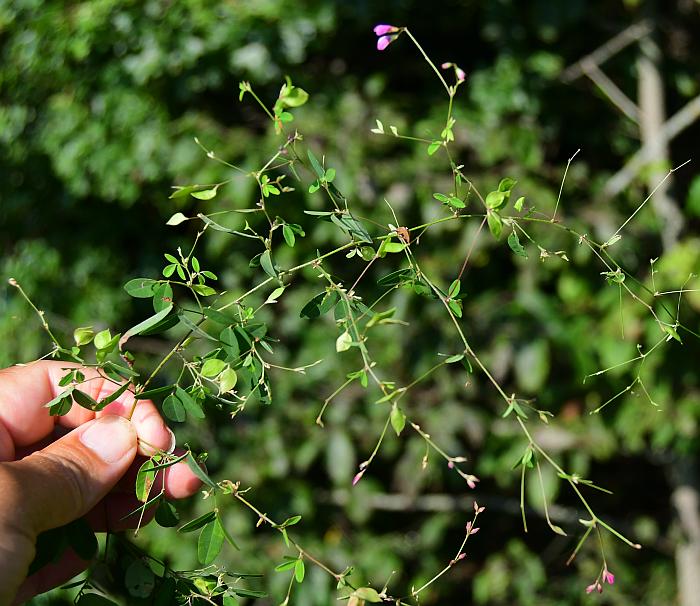Lespedeza repens (L.) W.P.C. Barton
Creeping Lespedeza

Native
CC = 4
CW = 5
MOC = 46
© SRTurner
Lespedeza repens (L.) W.P.C. BartonCreeping Lespedeza | |
 |
Native CC = 4 CW = 5 MOC = 46 |
© SRTurner |
|
Family - Fabaceae/Faboideae Habit - Perennial forb, branched and mat-forming.
Stems - Prostrate or trailing with ascending tips, to 1.0 m, 0.7-2.0 mm in diameter near the base, usually mat-forming, branched above and below the midpoint, sparsely to moderately pubescent with antrorse hairs.
Leaves - Alternate, trifoliate, stipulate, petiolate. Primary median leaves with the petiole mostly relatively short and slender, 3-8 mm long, 0.2-0.5 mm wide, sparsely appressed-hairy. Stipules 1.5-3.0 mm long, linear to hairlike. Leaflets 8-18 mm long, 5-12 mm wide, obovate, oblong, or elliptic, rounded or occasionally broadly angled at the base, rounded at the tip, the midvein usually extended as a minute, sharp point at the very tip, the upper surface glabrous or sparsely appressed-hairy, the undersurface sparsely to moderately appressed-hairy. Axillary leaves absent or rarely present but then relatively poorly developed.
Inflorescences - Axillary from upper and often also median leaves, unbranched or branched, appearing leafy, much exceeding the leaves. Flowers mostly 2-8 per raceme or branch, the axis not hidden by the flowers.
Flowers - Calyces with the tube 1.5-2.0 mm long, the 5 lobes 2-3 mm long. Corollas papilionaceous, 5-7 mm long, pink to pinkish purple or rarely purple, the banner usually darker purple toward the base, the wings and keel usually darker colored at the tips, the keel about as long as or slightly longer than the wings. Stamens 10, 9 of the filaments fused and 1 free nearly to the base, the anthers small, attached near the midpoint, all similar in size. Ovary ellipsoid to ovoid, sessile or short-stalked, the style slender, usually glabrous, straight in chasmogamous flowers and recurved in cleistogamous flowers, persistent at fruiting, the stigma small and terminal.
Fruits - Modified legumes, flattened, elliptic, 1-seeded, those from open flowers 5-6 mm long (including the stalk), the calyx covering about the lower 1/3-1/2; those from cleistogamous flowers 3-4 mm long, the calyx covering the lower 1/4-1/2. Seeds 2-3 mm long, olive green to light brown.
Flowering - July - October. Habitat - Forest openings, glades, prairies, streambanks, pond margins, fields, railroads, roadsides. Origin - Native to the U.S. Lookalikes - L. procumbens, also Kummerowia spp. Other info. - This mat-forming species is often missed or ignored, having very small flowers which are not exactly showy. In Missouri it occurs mostly south of the Missouri River. Its larger range extends throughout most of the southeastern continental U.S. It is recognized by its prostrate habit, small pink or purple flowers of the bean pattern (papilionaceous), and slender stems with appressed hairs. Its close sibling L. procumbens looks similar but has stems which are more conspicuously pubescent with dense, spreading hairs. L. repens also bears some passing resemblance to species of Kummerowia (Japanese or Korean lespedeza), but those plants have stipules which are larger, tan, and papery, and leaflets with conspicuous herringbone venation. Photographs taken at Otter Slough Conservation Area, Stoddard County, MO, 8-17-2021 (SRTurner). |